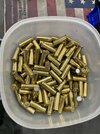I thought I'd post here since we do not have a dedicated ammunition umbrella.
This is on a lighter note

I've been finding myself going through the failure-to-feed, failure-to-fire discard bins at my range.
Never know what may be sitting there. Part curiosity, part demonstrating the visitors with me the calibers we do not shoot or have on hand.
Somehow I feel this is an acceptable and nobler form of garbage bin rummaging. What do you think?
You can easily visualize the difference between 5.56 and .223, or keep an interesting one for research.. and all in between.
As an aside, failures-to-fire that I could chamber that day or another never failed to fire given the second chance. Huh. I eagerly try them. Why not?
I have avoided the really crooked failures-to-feed.
Latest finds are several of Turkish 7.92 Mauser from the 40s (I will try to fire them, I've read they are hot, corrosive and have spotty reliability) and a 7.62x54R silvertip that is just asking for country and date of origin research.
A an incendiary and provocative question for the ammunition experts here

Could you think of calibers found in the discard bin that from the looks could lead you to a snap mistake of believing you can chamber and fire it that day or next in one of your firearms - and in reality are not compatible, but may chamber without alarming you, or, worse, fire, potentially creating a hazard.
Please list the dangerously-close-but-incompatible calibers and, respectively, chambers you own!


